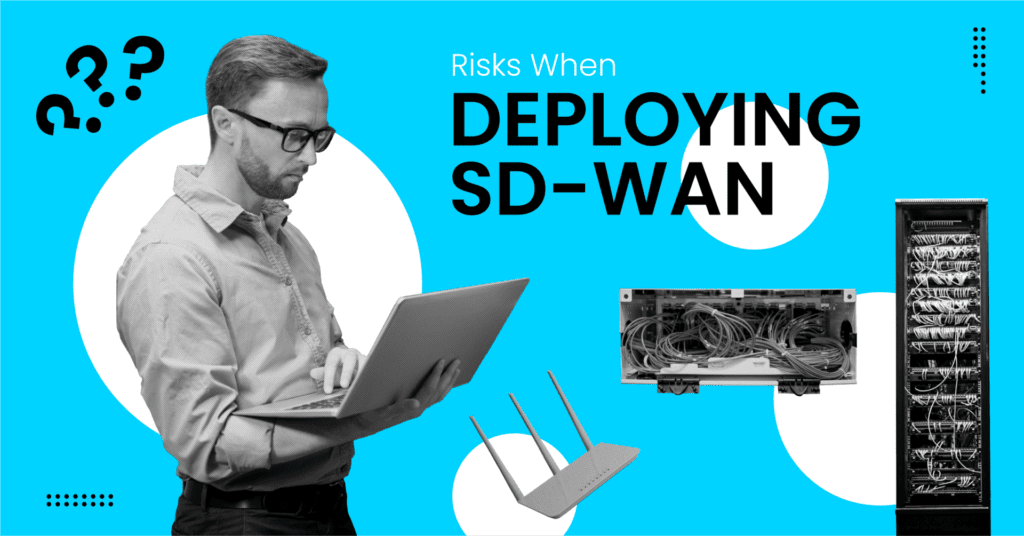Software-Defined Wide Area Network (SD-WAN) is a commonly deployed and robust solution to address the limitations of traditional network architectures. However, while SD-WAN offers numerous advantages, transitioning to this technology regularly involves navigating certain risks and challenges. In a recent interview with the technical team here at iTel Networks, key insights were shared regarding these risks and how businesses can mitigate them effectively.
The Cost Factor: Initial Investments and Long-Term Savings
One of the primary considerations for any company contemplating a shift to SD-WAN is the cost. SD-WAN requires specific equipment or appliances at each site, which comes with a price tag. This upfront cost might seem daunting for companies, especially those with limited capital for technological upgrades.
However, at iTel Networks, we have strategies to ease this burden. By amortizing the hardware costs into a monthly recurring charge (MRC), we make the transition more financially manageable. This approach ensures that the initial investment doesn’t become a roadblock for businesses looking to leverage SD-WAN’s benefits.
SD-WAN, however, should be considered a necessary investment for any modern company looking to grow. The return on investment goes beyond reducing WAN costs of more traditional systems, such as MPLS.
SD-WAN return on investment (ROI) may take the form of:
- Increased Network Resilience
- Increased Productivity
- Increased Security Performance
- Risk Mitigation
- Ability to Scale
Techspective estimates that for a 100-site organization, SD-WAN could offer up to 5x return on investment with a payback period as short as 12 months.
Choosing the Right Platform: Avoiding the Pitfalls
Selecting the appropriate SD-WAN platform is another crucial step that carries its risks. Without a thorough understanding of their specific requirements and pain points, businesses may choose a solution that doesn’t align with their needs.
This is where professional guidance becomes invaluable. SD-WAN experts will have worked with a multitude of vendors and industry verticals, learning along the way what equipment, software, and platforms are the best for your business. Their advanced knowledge will help smaller IT departments navigate this decision-making process, ensuring that the chosen SD-WAN solution is tailored to their unique requirements.
Planning Ahead: Creating a Clearer Picture
For most organizations looking to deploy SD-WAN, this will be a new venture to explore. You will likely have legacy equipment and infrastructure that has been invested in over the years, possibly even having older network setups, such as MPLS, in place. You may be asking yourself, “What can you keep?” or “Will my current equipment integrate seamlessly?”.
Effective planning is essential for a smooth transition to SD-WAN. Businesses need to have a comprehensive understanding of their current network setup and the specific elements they wish to retain. Our technical team offers this advice, “You want to have a really good understanding of what you have in place today. Make sure your network documentation is up to date. Consider a network assessment to discover what’s on your network and plan accordingly.”
This meticulous preparation involves identifying which existing network components, such as firewalls, need to be integrated with the new SD-WAN setup. Having a good idea of what investments you’ve made and want to keep is crucial for designing a compatible solution.
Items you may want to include in your SD-WAN transition documentation could be:
Network Inventory:
- Current WAN architecture: Topology, hardware, and software in use.
- Devices and endpoints: Routers, switches, firewalls, etc.
- IP addressing scheme: Subnets, IP ranges, and assignments.
- Bandwidth utilization: Current usage, peak times, and trends.
Configuration Details:
- Routing protocols: OSPF, BGP, EIGRP, etc.
- Security policies: Firewall rules, VPN configurations, ACLs.
- Quality of Service (QoS) settings: Traffic prioritization and shaping policies.
- Connectivity and Performance:
Applications and Services:
- Critical applications: List of applications that need prioritization.
- Service dependencies: Dependencies between applications and services.
Integration Challenges: Navigating the Transition
A common scenario we assist with is the transition from an MPLS network to an SD-WAN setup. This migration involves a series of technical and operational challenges. One significant hurdle is the integration process, particularly for businesses with multiple distributed sites. Our Sales Engineers explained, “It’s difficult to cut over all 20 sites on the same night to an SD-WAN solution. What practically happens is a few sites at a time over a number of weeks will get cut over at night.”
During this phased transition, maintaining network stability requires dynamic routing. MPLS systems often rely on static routing, which does not automatically learn new SD-WAN routes. To overcome this, businesses need to make the switch to dynamic routing protocols like BGP (Border Gateway Protocol). Working with your current MPLS provider will be necessary to ensure a successful SD-WAN deployment.
Keep in mind this change can be administratively intensive and requires significant pre-work. Failure to prepare adequately might deter businesses from switching. However, with proper planning and support, the long-term benefits of SD-WAN make this initial effort worthwhile.
The Flexibility and Future-Proofing of SD-WAN
One significant advantage of SD-WAN is the operational flexibility it provides post-implementation. While the initial transition might be complex and resource-intensive, the long-term benefits outweigh these challenges.
SD-WAN offers greater adaptability and scalability compared to traditional MPLS systems. This flexibility ensures that businesses can easily accommodate future growth and changes in their network requirements. Additionally, SD-WAN is better aligned with Cloud-based and SaaS services that businesses use. Unlike traditional MPLS, which often routes traffic through a central firewall at the head office, SD-WAN allows sites to connect directly to the Internet to access these services. This approach not only improves efficiency but also maintains consistent security policies across all sites, ensuring robust security without the bottlenecks associated with centralized systems.
Want to go further and add wireless 5G backup internet? It’s simple. Want to push configuration to all of your sites? It’s easy. SD-WAN modular aspects really allow businesses to accomplish anything from zero-touch provisioning and configuration to adding new sites and security protocols without hassle.
Balancing Risks with Rewards
Deploying SD-WAN involves a careful balance of addressing potential risks while leveraging its numerous rewards. From managing initial costs and selecting the right platform/provider to navigating integration challenges and thorough planning, each step requires thoughtful consideration. However, with the right approach and professional guidance, the transition to SD-WAN can lead to significant long-term benefits, including cost savings, improved network performance, and enhanced flexibility.
At iTel Networks, we are committed to helping businesses make this transition smoothly and effectively. Our expertise and tailored solutions ensure that your journey to SD-WAN is as seamless as possible, empowering your business with a future-proof network that meets your evolving needs. If you are considering SD-WAN for your organization, reach out to us to learn more about how we can support you through this transformative process.





